Janice Hardy's Blog, page 85
January 18, 2019
Alternative Ways to Describe Character Reactions
 By Janice Hardy, @Janice_Hardy
By Janice Hardy, @Janice_Hardy This week's Refresher Friday takes an updated look at ways to keep your emotional descriptions fresh. Enjoy!
I frequently receive questions about finding good alternative ways to use common reaction/emotion words. He smiled. She gulped. He frowned. She cringed. (Actually, that’s a story right there, isn’t it? He sounds like a stalker to me) Anyway…
These words get used a lot because they’re good words and get the point we're trying to make across. Smiling to show happiness, frowning to show displeasure, gulping to show fear. But after a while, characters reacting to the same emotions the same way over and over feels repetitive.
However, switching it up too much can lead to overwriting. If a character never smiles, but beams, smirks, grins, curls a lip, corners of the mouth rise, and all the other various ways we write to say "smile," it can feel awkward. Like "said," "smiled" and the like are fairly invisible, so while readers do notice them, they don't tend to stick out unless they are too many of them.
Continue ReadingWritten by Janice Hardy. Fiction-University.com

Published on January 18, 2019 03:30
January 17, 2019
Why the Ending of Galaxy Quest Always Makes Me Cry
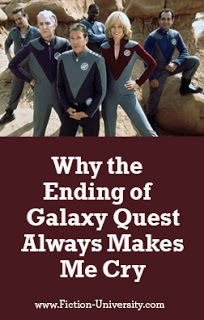 By David Mack, @DavidAlanMack
By David Mack, @DavidAlanMackPart of The Writer's Life Series
JH: Stories have the power to inspire us, move us, and profoundly change us. Please help me welcome David Mack to the lecture hall today, to share a story that moves him, and explain why we should never take what we do for granted.
David Mack is the award-winning and New York Times bestselling author of more than thirty novels of science fiction, fantasy, and adventure.Mack’s writing credits span several media, including television (for episodes of Star Trek: Deep Space Nine), short fiction, and comic books. His new novel The Iron Codex is available now from Tor Books.
Website | Facebook | Twitter | Goodreads | Tor
Take it away David...
Continue ReadingWritten by Janice Hardy. Fiction-University.com

Published on January 17, 2019 05:20
January 16, 2019
Get Over Overstating: Trimming Unnecessary Words in Your Manuscript
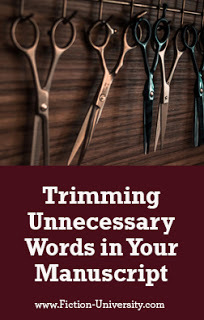 By Janice Hardy, @Janice_Hardy
By Janice Hardy, @Janice_Hardy Today's Afternoon Rewind takes another look at ways to cut words from your manuscript.
Often, when we tinker with our manuscripts we repeat ourselves. Sometimes this is good, as it reinforces critical elements of the story, but sometimes it just bloats the story and adds extra words. Here are some tips on finding--and eliminating--those unnecessary words in your own work.
Words That Tell Readers Everything
A common unnecessary word or phrase is one that states something the reader can clearly figure out from the text. Trimming it can tighten the prose and make it read more smoothly.
I darted to the window [and peeked out.] Enzie was running down the walk, waving her arms above her head and yelling.It's clear that the narrator here looks out the window after she darts to it because she tells you what she sees. Leaving in "and peeked out" won't hurt the story, but the goal is to start picking up the pace in this scene since something bad is about to happen. Having a shorter sentence achieves that.
Continue ReadingWritten by Janice Hardy. Fiction-University.com

Published on January 16, 2019 12:30
The Difference Between Critique Partners and Beta Readers
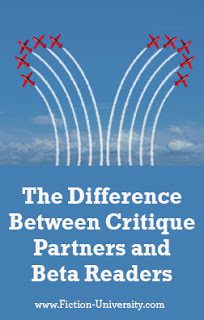 By Janice Hardy, @Janice_Hardy
By Janice Hardy, @Janice_Hardy Critique partners and beta readers have similar jobs, but they’re not the same thing.
January is a common month to start revisions and the search for critique partners and beta readers, and my various social media feeds are always filled with comments and thoughts related to both.
This year, I received a direct question from a reader about the difference between a critique and a beta read—and the people who do them.
Like so many other writing terms, these are often used interchangeably, but have slightly different meanings.
Continue ReadingWritten by Janice Hardy. Fiction-University.com

Published on January 16, 2019 05:50
January 15, 2019
Uncovering the Mysteries of Narrative Flow in the Opening of Stephen King's 11/22/63
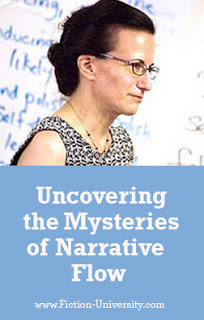 By Jeanne Cavelos
By Jeanne CavelosPart of the How They Do It Series
JH: Studying the masters is a wonderful way to improve your own writing, and Stephen King is certainly one of the masters. Please help me welcome Jeanne Cavelos to the lecture hall today, to learn more about how King uses narrative flow in his novel, 11/22/63.
Jeanne Cavelos is the director of the Odyssey Writing Workshops Charitable Trust, a 501(c)(3) nonprofit organization devoted to helping writers of fantasy, science fiction, and horror improve their work.
Jeanne began her professional life as an astrophysicist working at NASA. After earning her MFA in creative writing, she moved into a career in publishing, becoming a senior editor at Bantam Doubleday Dell, where she edited award-winning science fiction, fantasy, and horror novels and won the World Fantasy Award. Jeanne left New York to pursue her own writing career and find a more in-depth way of working with writers. She has had seven books published; her last novel was Invoking Darkness , the third volume in her best-selling trilogy The Passing of the Techno-Mages . Her writing has twice been nominated for the Bram Stoker Award.
Jeanne is currently working on a near-future science thriller, Fatal Spiral. Since Jeanne loves working with developing writers, she created the Odyssey Writing Workshop in 1996, which quickly became one of the most respected programs in the world for writers of the fantastic. In 2010, she launched Odyssey Online Classes; live, intensive, interactive courses that use the techniques that have proven so effective at the workshop. Three online classes are announced each fall with application deadlines in December. The class Getting the Big Picture: The Key to Revising Your Novel will include the issues discussed in this article. Jeanne is also an English lecturer at Saint Anselm College, where she teaches fiction and nonfiction writing.
Website | Blog | Facebook | Twitter | Pinterest | Goodreads.
For more information about Odyssey, check out this YouTube video.
Take it away Jeanne...
Continue ReadingWritten by Janice Hardy. Fiction-University.com

Published on January 15, 2019 03:00
January 14, 2019
Titles: The First Impression a Novel Makes
 By Janice Hardy, @Janice_Hardy
By Janice Hardy, @Janice_Hardy A new mini-feature starts this week here at Fic-U--the Afternoon Rewind. Monday, Wednesday, and Friday, I'll pull an article out of the archives that still offers useful advice, even if it's been gather e-dust for a awhile. Today's rewind is all about how titles affect our novels.
I have a bit of a love/hate relationship with titles. They either come to me like bolts from the blue, or I spend months struggling to find the right one. Usually, the easier the title comes to me, the more well-formed the story idea is.
When this happens, I know I've tapped into a critical element of the story, and that element will likely resonate throughout the entire novel. That's the power of the right title.
The cliché says you can't judge a book by its cover, but readers do judge them by their titles. A great title will catch the eye and entice a reader to pick up your book, while a bad title will keep readers away or attract the wrong readers for your story.
Continue ReadingWritten by Janice Hardy. Fiction-University.com

Published on January 14, 2019 12:30
Three Ways Moral Dilemmas Can Strengthen Your Novel
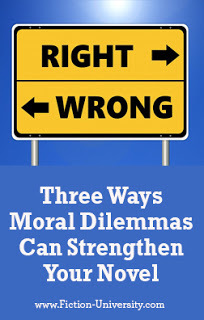 By Janice Hardy, @Janice_Hardy
By Janice Hardy, @Janice_Hardy Moral ambiguity can bring a lot to a novel.
For me, writing is a bit of a psychological experiment. I love creating morally gray situations and seeing how my characters react to them. What they do, what lines they cross, how far they’re really willing to go to get what they want. It’s a wonderful way to learn who they are and tell a richer story.
When situations aren’t so back and white, it gives us more opportunities to explore our story’s themes and characters. We can push boundaries to make a point or illustrate an idea. We can raise tensions and provide the emotional depth that keep readers invested. Life is messy, so why not take advantage of that with the tales we tell?
Here are three ways moral dilemmas can benefit your novel:
Continue ReadingWritten by Janice Hardy. Fiction-University.com

Published on January 14, 2019 06:24
January 12, 2019
Real Life Diagnostics: Is This Fight Scene Working?
 Critique By Maria D'Marco
Critique By Maria D'Marco Real Life Diagnostics is a weekly column that studies a snippet of a work in progress for specific issues. Readers are encouraged to send in work with questions, and we diagnose it on the site. It’s part critique, part example, and designed to help the submitter as well as anyone else having a similar problem.
If you're interested in submitting to Real Life Diagnostics, please check out these guidelines.
Submissions currently in the queue: Zero
Please Note: As of today, RLD slots are open.
This week’s question:
Is this fight scene working?
Market/Genre: YA Fantasy
On to the diagnosis…
Continue ReadingWritten by Janice Hardy. Fiction-University.com

Published on January 12, 2019 03:00
Sunday Writing Tip: Clean Up Your Dialogue Tags
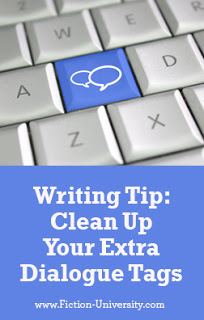 By Janice Hardy, @Janice_Hardy
By Janice Hardy, @Janice_Hardy Each week, I’ll offer a tip you can take and apply to your WIP to help improve it. They’ll be easy to do and shouldn’t take long, so they’ll be things you can do without taking up your entire Sunday. Though I do reserve the right to offer a good tip now and then that will take longer—but only because it would apply to the entire manuscript.
This week, delete unnecessary dialogue tags.
Dialogue tags are important, but not every spoken line needs a “(s)he said” after it. Too many tags in a row sound clunky at best, melodramatic and silly in the extreme. Go through your tags and decide if you truly need it or not. In most cases, it’s clear who’s speaking, or there’s already stage direction or action attributed to the speaker.
Continue ReadingWritten by Janice Hardy. Fiction-University.com

Published on January 12, 2019 03:00
January 11, 2019
The Literary Tour Guide: How Much Do You Need to Describe Your Setting?
 By Janice Hardy, @Janice_Hardy
By Janice Hardy, @Janice_Hardy This week's Refresher Friday dips into 2012 to heavily update one of my favorite pieces on describing your setting. Enjoy!
Description is a blessing and a curse. Setting the scene is vital to help readers immerse themselves in your story world, but too much of it can bore readers and encourage them to skim past it. But find the proper balance between words and word pictures, and readers feel as though they've stepped into the book and live in you world.
How much do you need to describe your setting?
The pat answer is, "enough to make it feel real without bogging the reader down in too many details," but that isn't very helpful. How do you know how much detail is too much? Where is that fine line between immersive and oppressive? And the really frustrating part, is that there is no clear cut right answer. What is "enough" for an epic fantasy is usually too much for women's fiction, and what a thriller needs is different from a middle grade contemporary.
Let's look at a few guidelines.
Continue ReadingWritten by Janice Hardy. Fiction-University.com

Published on January 11, 2019 03:00



